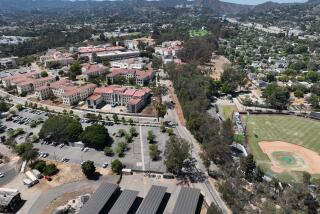L.A. Schools Trump Builder on Hotel Site : Courts: Ruling is a defeat for Donald Trump, who fought to make the district stick to its plan to buy Ambassador site.
- Share via
In a victory for the Los Angeles school district over developer Donald Trump, a court ruled Friday that the district is free to drop its bid to buy the historic Ambassador Hotel property, clearing the way for it to purchase another sorely needed high school site.
Los Angeles Superior Court Judge Barnet M. Cooperman threw out Trump-Wilshire Associates’ lawsuit to force the school district to stick to its plans to buy the Ambassador from them.
For thousands of elementary schoolchildren, the ruling means a new high school will be built closer to their homes in Downtown Los Angeles in four to five years, saving them from long bus rides to other campuses, district officials said.
The protracted battle over ownership and value of one of the city’s most widely known landmarks is likely to be the focus of more court battles, as Trump representatives fight to keep the school district’s $48-million deposit for the land.
“The district has treated us terribly and has been extremely cavalier about this,” said Trump spokeswoman Barbara Res. She said Trump’s next step will be to sue the district for damages because it unfairly tied up the Wilshire corridor property. “We are going to end up with the lion’s share of the $48 million.”
In September, the district decided to walk away from its pursuit of the Ambassador land, citing its tight finances and the dramatic decline in real estate values.
In the meantime, the district has negotiated with another developer to buy a 24-acre plot near Temple and Beaudry avenues Downtown. The state’s school construction board gave the district tentative approval to buy the new site with $30 million of the $50 million it had allocated to buy the Ambassador. The district forfeited the remaining $20 million in construction funding.
Trump attorneys argued that the district should not renege on its plans because it unfairly hurts Trump’s financial standing with the site. They claimed that he lost development opportunities while paying $1 million a month in maintenance.
“It is an abuse of power. . . . They don’t want to buy it now because it is too expensive,” charged William M. Bitting, who said the district’s real plan is to buy the property for less money at a later date.
James W. Colbert, an O’Melveny & Myers attorney representing the district, argued that the contractual agreement with Trump allowed the district to drop the bid. He also contended that Trump has benefited from the interest-free use of the district’s $48-million deposit on the land, which Trump used to help pay off the mortgage. Trump paid $64 million for the site in 1989.
Cooperman sided with the district, saying that Trump-Wilshire Associates had not proven that its financial position with the site has worsened. He said Trump has the right to seek damages through other court avenues.
The Friday ruling forces Trump to refund the district’s deposit with interest within a year. However, litigation could stall or prevent the pay-back if a judge later rules that Trump has been hurt by the district’s decisions.
School officials put up district headquarters as collateral to obtain the $48-million loan for the deposit.
Since 1990 the district has been fighting with Trump over the value of the Ambassador site. Trump set its worth at more than $110 million. The district offered $45 million.
When the parties failed to agree on the price, the district used its authority to take property through eminent domain proceedings, which give government entities the power to buy land from property owners for fair market value.
Throughout the early fight, school board members were adamant about the need to build a high school in the area, where about 3,000 Mid-Wilshire teen-agers are bused to Valley and Westside high schools because their neighborhood schools are overcrowded.
Both sides were headed for trial this fall to determine the cost. Under state laws, the jury would be required to set the Ambassador price at land values in 1990, when eminent domain proceedings began. With today’s depressed real estate market, the district would have faced the likelihood of paying an inflated price for the land.
More to Read
Sign up for Essential California
The most important California stories and recommendations in your inbox every morning.
You may occasionally receive promotional content from the Los Angeles Times.









